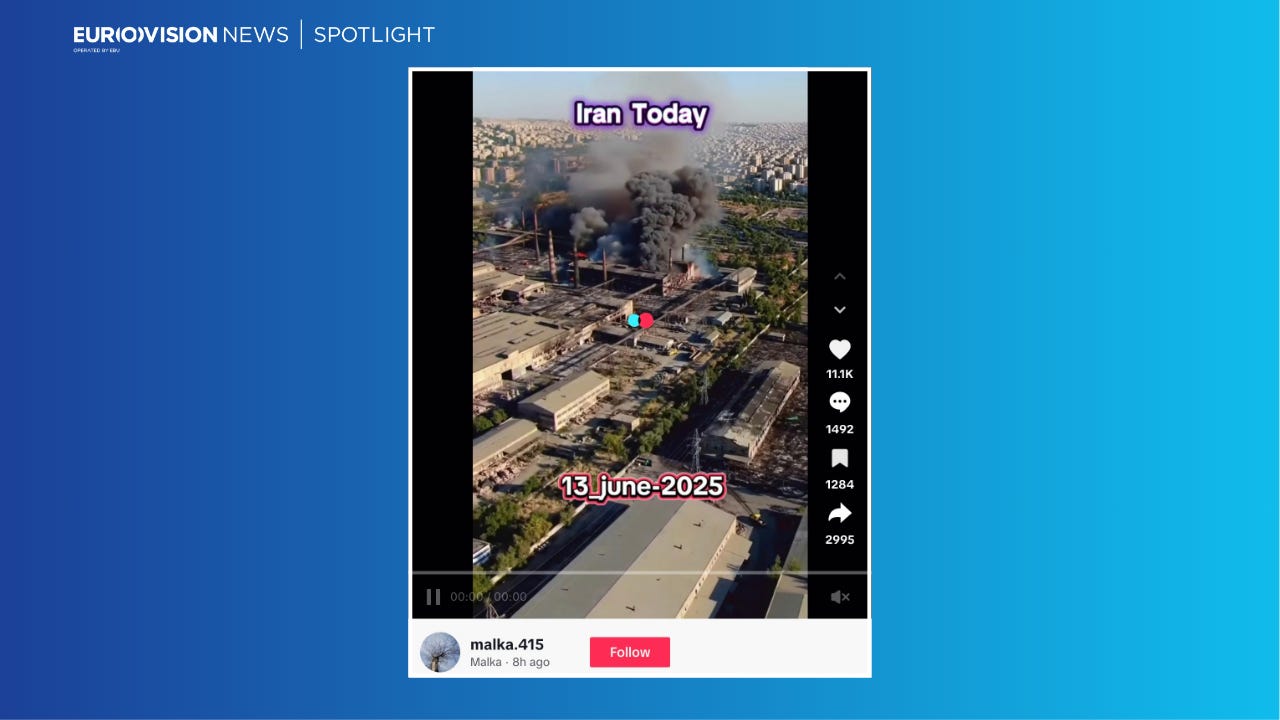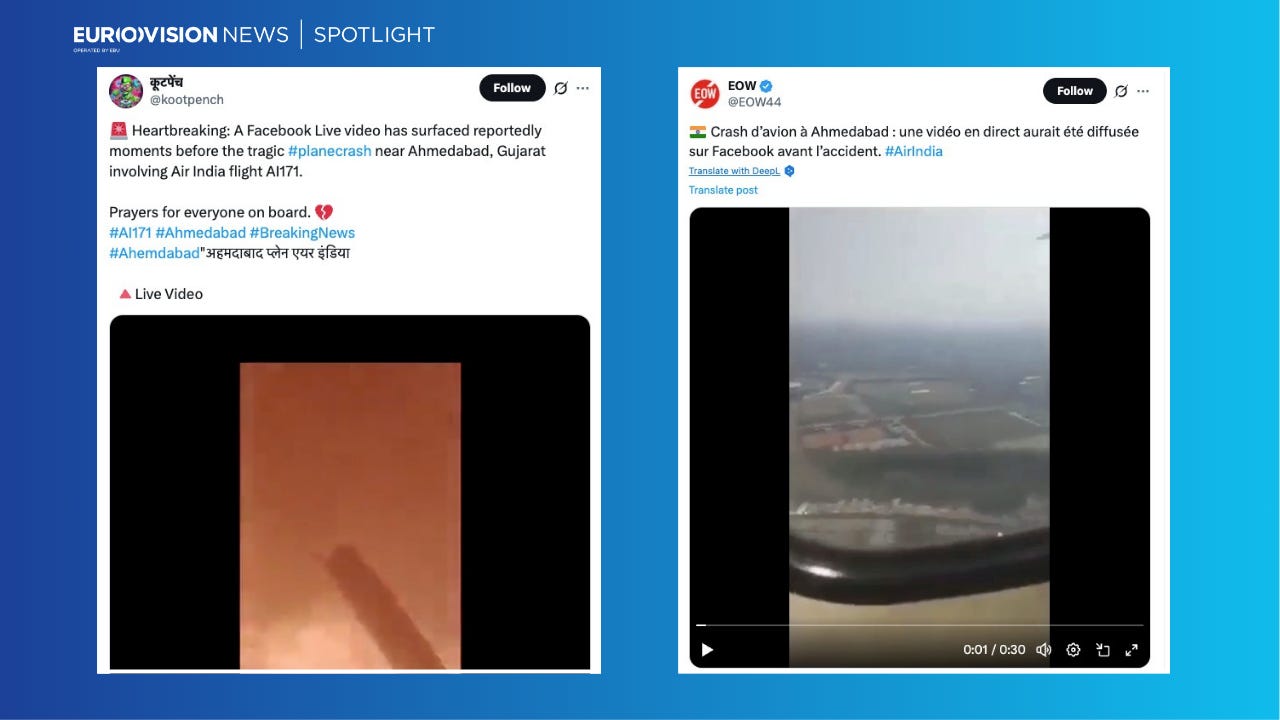Fact-Check Dispatch: Old and AI-generated content circulates amid Middle East conflict and India plane crash
Issue 23 of the Fact-Check Dispatch
On Thursday night into Friday morning, June 13, Israel launched a large-scale attack on Iran, killing several top Iranian commanders and nuclear scientists and escalating the ever-simmering tensions between the two nations into a full-blown conflict.
Soon after, Iran responded, first sending drones towards Israel which were intercepted by the Iron Dome air defence system. On Friday evening, the Iranian response heightened, with footage showing scenes of missile fire raining down on Israeli cities.
Over the weekend, the two countries traded attacks. Iran reported that at least 224 people were killed since the Israeli attacks began on Friday. Israel reported 24 deaths in the same period.
On June 12, at least 270 people were killed when an Air India passenger plane crashed shortly after takeoff from the western Indian city of Ahmedabad. Just one of the 242 people on board survived, and dozens others were killed on the ground as the plane struck a student accommodation building near the city’s airport.
Both of these major stories led to massive amounts of content being shared online, not all of which was trustworthy.
Here’s our fact-check dispatch.
Israel-Iran conflict escalates
With a huge amount of content widely circulating online about the Israel-Iran conflict, newsroom verification teams were working to verify real videos from the various incidents.
However, there were also fakes in circulation, showing just how carefully everything must be checked during a big news event like this.
For Radio France’s franceinfo, Thomas Pontillon and Valentine Joubin urged caution about false videos. They write: “Most of them date from last October when Tehran targeted Israel after the death of the leader of Hezbollah in Lebanon, a very close ally of Iran.”
Pontillon and Joubin also warned readers to beware of accounts that appeared to be official sources but were not. We have covered some of these before — verified accounts for “Mossad” and the “Iran Military” have no connection to the official organisations they purport to represent. Some of them clearly state in the account bio that they are commentary or parody accounts, but others require a closer inspection. In this case, as in many others, the paid verification programme on X has muddied the waters when it comes to recognising official sources on the platform.
To accommodate such a fast-moving story, the team at BBC Verify was running a live blog updating the public on its verification work as it happened on Friday, June 13.
Sebastian Vandermeersch found that a video originating in Syria over a year ago was found to be in circulation again, purporting to show an Iranian drone tangled in power cables. It wasn’t the firswt time this video was posted false claiming to be new; it also did the rounds in April 2024, during another escalation between Israel and Iran.
Paul Brown gave information about satellite imagery from Iran that showed signs of damage at the Natanz nuclear facility. He writes: “The image was captured by the US company Umbra Space using Synthetic Aperture Radar (SAR), rather than more conventional methods. The result is a high resolution, black and white image of the earth’s surface. The benefit of this technology is that it cuts through cloud cover, which can often obscure images captured by conventional satellites.”
Meanwhile Rob Corp cautioned that on Friday afternoon, the Iranian government said it had placed “temporary restrictions” on internet connections, which would limit the amount of material that was coming out of the country showing the situation.
For Deutsche Welle, Alima de Graaf and Tilman Wagner write about many of the viral videos in circulation were actually fake. In one instance, a video with hundreds of thousands of views on TikTok claiming to show Iranian sites hit on June 13 was actually AI-generated. How did they figure it out? Several odd details, including a distorted teddy bear that looked too clean for its surroundings, and statue-still firefighters that vanished into thin air.
In another case, an image on X that racked up 4.5 million views was posted with the caption: “IRAN HAS LAUNCHED MISSILES AT ISRAEL.” At the time of the post, there had been no confirmation of any missile strikes yet — Iran first responded with drones.
More probing further confirmed that the image wasn’t from that day. De Graaf and Wagner write: “A reverse image search reveals the photo in the post is from a military exercise in Iran several years ago. The image first appeared online in 2021. The photograph appears to have been taken in southern Iran during the 17th Iranian Revolutionary Guard Corps (IRGC) joint Great Prophet 17 exercise in December 2021, which included the launch of rockets and missiles as part of a five-day military drill.”
Derek Bowler looked at another video for Eurovision News Spotlight, purporting to show Israeli drones hitting targets in Iran. A reverse image search revealed a version of it posted in October 2024.
Bowler writes: “This particular piece of content has been misrepresented in several conflicts, mostly recently during Operation Sindoor, after India launched missile strikes on Pakistan on May 7, 2025.”
Turning away from fake content, the team at the France 24 Observers analysed the initial images released by the Israeli military. They geolocated an area seen in an IDF video as being about 10 kilometres from Borujerd in western Iran, but were unable to say that the site had been hit.
Air India crash sparks misinformation
An Air India Boeing 787-8 Dreamliner was en route to London when it crashed shortly after takeoff in Ahmedabad. Immediately after reports emerged of the crash, footage and images were shared by local people showing clouds of black smoke rising into the sky. In among the genuine videos that were circulating after the crash, some items immediately raised suspicion.
One of them was a clip purporting to show the moment of the crash as filmed from inside the aircraft. Maria Flannery writes for Eurovision News Spotlight that it was actually filmed during a plane crash in Nepal in early 2023, which killed everyone on board, including the man filming.
“We were also independently able to find news coverage of the man’s final moments in 2023 via a Google Lens reverse image search. In addition to this, it is also possible to debunk claims this showed an Air India flight by comparing colour scheme and branding of the interior of the plane.”
For VerificaRTVE, LM, Paula Peña and Mario Pérez write of another similar example showing smoke filling up the inside of a plane. This was actually filmed during an incident on a Ryanair plane that took off from Bucharest in 2020.
Both Eurovision News Spotlight and VerificaRTVE also uncovered a number of examples of AI-generated content being circulated, presented as photos of the crash.
Israel’s online ad campaign for Gaza tourism utopia
The state of Israel bought millions of euro worth of online ads targeting European countries including Finland, an investigation by YLE’s Satu Helin, Eero Mäntymaa, Samuli Huttunen, and Ville Juutilainen found.
One such video created using AI resembled a travel ad, showing happy tourists, beautiful beaches and luxury hotels and bars. The video claimed: This is what Gaza could have been if there were no Hamas.
“The video is an example of propaganda produced by the Israeli state, which Israel uses paid online advertising to spread,” the authors write. “The Eurovision ads, [a state-funded campaign for Israel’s Eurovision Song Contest entry] which also attracted attention in Finland, are only a small part of Israel’s long-running media campaign.”
With these ads, “Israel wants to convey its own message to the global audience,” the YLE team writes.
“In its advertisements, Israel has claimed, among other things, that there is no famine in Gaza, that Israel supplies humanitarian aid to Gaza without restrictions, and that the problems in the region are the fault of the terrorist organisation Hamas.”
The investigative reporters probed the contents of the ads and their reach across Europe.

















